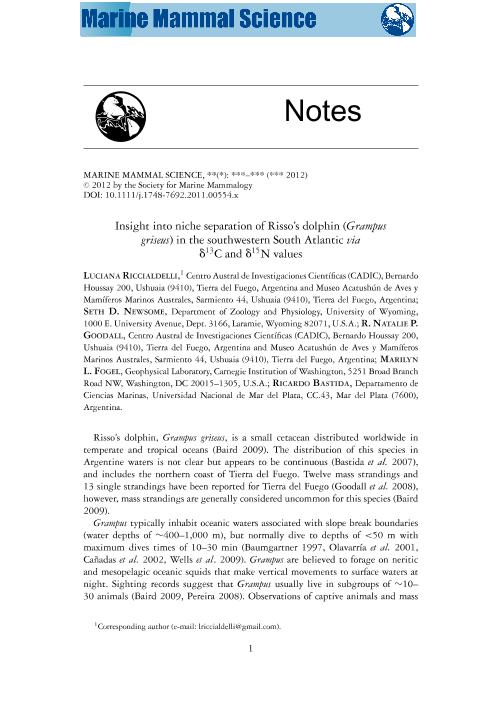Mostrar el registro sencillo del ítem
dc.contributor.author
Riccialdelli, Luciana

dc.contributor.author
Newsome, Seth Darnaby

dc.contributor.author
Prosser Goodall, Rae Natalie

dc.contributor.author
Fogel, Marilyn

dc.contributor.author
Bastida, Ricardo Oscar

dc.date.available
2021-03-15T11:42:15Z
dc.date.issued
2012-10
dc.identifier.citation
Riccialdelli, Luciana; Newsome, Seth Darnaby; Prosser Goodall, Rae Natalie; Fogel, Marilyn; Bastida, Ricardo Oscar; Insight into niche separation of Risso's dolphin (Grampus griseus) in the southwestern South Atlantic via d13C and d15N values; Wiley Blackwell Publishing, Inc; Marine Mammal Science; 28; 4; 10-2012; 503-515
dc.identifier.issn
0824-0469
dc.identifier.uri
http://hdl.handle.net/11336/128311
dc.description.abstract
Risso’s dolphin, Grampus griseus, is a small cetacean distributed worldwide in temperate and tropical oceans (Baird 2009). The distribution of this species in Argentine waters is not clear but appears to be continuous (Bastida et al. 2007), and includes the northern coast of Tierra del Fuego. Twelve mass strandings and 13 single strandings have been reported for Tierra del Fuego (Goodall et al. 2008), however, mass strandings are generally considered uncommon for this species (Baird 2009). Grampus typically inhabit oceanic waters associated with slope break boundaries (water depths of ∼400–1,000 m), but normally dive to depths of <50 m with maximum dives times of 10–30 min (Baumgartner 1997, Olavarr´ıa et al. 2001, Canadas ˜ et al. 2002, Wells et al. 2009). Grampus are believed to forage on neritic and mesopelagic oceanic squids that make vertical movements to surface waters at night. Sighting records suggest that Grampus usually live in subgroups of ∼10– 30 animals (Baird 2009, Pereira 2008). Observations of captive animals and mass strandings indicate that cohesive subgroups may be composed of same sex and similar aged individuals (Baird 2009, Bearzi et al. 2010), and therefore sex- and age-related dietary preferences may result from this behavior (Cockcroft et al. 1993). Also, large aggregations of Grampus can occur in response to abundant but ephemeral pulses of productivity related to oceanographic fronts that attract their primary prey squid (Davis et al. 2002, Bearzi et al. 2010). As in other regions, Grampus have also been observed in inshore waters at specific times of the year in several areas of the southwestern South Atlantic, including central Patagonia (Reyes 2006) and Pen´ınsula Valdes (W ´ ursig and W ¨ ursig 1980; R. Bastida, personal observation). ¨ Sighting records suggest that this species may move seasonally between inshore and offshore waters (Best 2007). The ecology of Grampus in the southwestern South Atlantic has never been intensively studied. Little is known about its food habits, distribution, movements, seasonal occurrence, reproduction, or population structure, likely because it inhabits offshore waters and there are few sighting and stranding records along the remote coasts in this region. Nevertheless, bone collected during several stranding events in Tierra del Fuego provides a unique opportunity to study the ecology of this species via stable isotope analysis (SIA). Recently, SIA of bone collagen from 48 Grampus individuals that stranded in NE Tierra del Fuego showed a striking bimodal distribution in both mean 13C and 15N values (Riccialdelli et al. 2010). These specimens were treated as two feeding groups, GG1 (n = 23 individuals) and GG2 (n = 25 individuals) and we speculated that they inhabited different feeding grounds at different latitudes in the southwestern South Atlantic Ocean. Since SIA offers information on both dietary and habitat preferences (Syvaranta ¨ and Jones 2007, Newsome et al. 2009) it would be a useful tool to evaluate aspects of the ecological niche of Grampus that are difficult to characterize using traditional approaches (e.g., observation or stomach content analysis). 15N differences between top consumers and particulate organic matter or primary consumers provide a way of estimating the trophic level of Grampus (e.g., Cabana and Rasmussen 1996, Post 2002). 13C values can be used to characterize habitat preferences since carbon isotope values differ between inshore and offshore marine food webs (DeNiro and Epstein 1978, Clementz and Koch 2001) Differences in baseline (i.e., base of the food web) 13C and 15N values have been reported in particulate organic mater (POM) and plankton along latitudinal and longitudinal gradients in different parts of the world, including the southern waters of Argentina (Rau et al. 1982, Dunton et al. 1989, Goericke and Fry 1994, Schell et al. 1998, Laraet al. 2010). These baseline differences cascade up food webs to top marine consumers allowing for the study of movement patterns, migration and even stock distinction in marine mammals (e.g., Best and Schell 1996, Walker and Macko 1999, Witteveen et al. 2009). Comparison of Grampus 13C and 15N values with that of baseline POM (or plankton) values if available, or with putative prey collected in different regions/habitats, is the most direct approach to assess its habitat use and movement patterns (e.g., Burton and Koch 1999, Das et al. 2003, Witteveen et al. 2009).
dc.format
application/pdf
dc.language.iso
eng
dc.publisher
Wiley Blackwell Publishing, Inc

dc.rights
info:eu-repo/semantics/openAccess
dc.rights.uri
https://creativecommons.org/licenses/by-nc-sa/2.5/ar/
dc.subject
RISSO'S DOLPHIN
dc.subject
GRAMPUS GRISEUS
dc.subject
d13C
dc.subject
d15N
dc.subject
SOUTH ATLANTIC OCEAN
dc.subject
TIERRA DEL FUEGO
dc.subject.classification
Ecología

dc.subject.classification
Ciencias Biológicas

dc.subject.classification
CIENCIAS NATURALES Y EXACTAS

dc.title
Insight into niche separation of Risso's dolphin (Grampus griseus) in the southwestern South Atlantic via d13C and d15N values
dc.type
info:eu-repo/semantics/article
dc.type
info:ar-repo/semantics/artículo
dc.type
info:eu-repo/semantics/publishedVersion
dc.date.updated
2021-02-10T16:58:32Z
dc.journal.volume
28
dc.journal.number
4
dc.journal.pagination
503-515
dc.journal.pais
Reino Unido

dc.journal.ciudad
Londres
dc.description.fil
Fil: Riccialdelli, Luciana. Consejo Nacional de Investigaciones Científicas y Técnicas. Centro Austral de Investigaciones Científicas; Argentina
dc.description.fil
Fil: Newsome, Seth Darnaby. University Of Wyoming (uw);
dc.description.fil
Fil: Prosser Goodall, Rae Natalie. Consejo Nacional de Investigaciones Científicas y Técnicas. Centro Austral de Investigaciones Científicas; Argentina
dc.description.fil
Fil: Fogel, Marilyn. Carnegie Institution Of Washington; Estados Unidos
dc.description.fil
Fil: Bastida, Ricardo Oscar. Consejo Nacional de Investigaciones Científicas y Técnicas; Argentina. Universidad Nacional de Mar del Plata. Facultad de Ciencias Exactas y Naturales. Departamento de Ciencias Marinas; Argentina
dc.journal.title
Marine Mammal Science

dc.relation.alternativeid
info:eu-repo/semantics/altIdentifier/url/https://onlinelibrary.wiley.com/doi/10.1111/j.1748-7692.2011.00554.x
dc.relation.alternativeid
info:eu-repo/semantics/altIdentifier/doi/https://doi.org/10.1111/j.1748-7692.2011.00554.x
Archivos asociados
